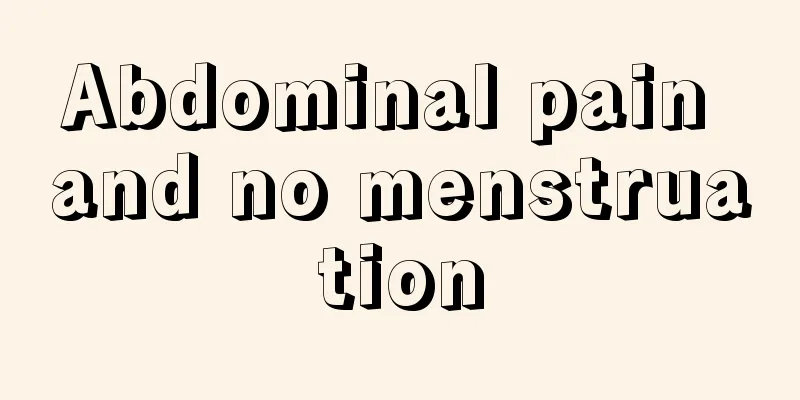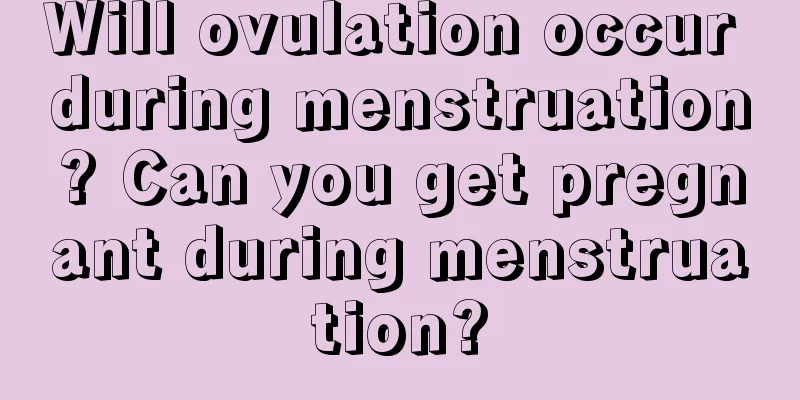Abdominal pain and no menstruation

|
It is normal for girls to experience dysmenorrhea during menstruation. As long as the pain is within an acceptable range, there is no need to go to the hospital for treatment. Girls should pay attention to their personal living habits during menstruation, keep warm, and drink appropriate amounts of brown sugar water, which can ensure that dysmenorrhea is relieved. During dysmenorrhea, there is usually vaginal bleeding. If there is no bleeding, it is considered that menstruation is delayed. So, what are the reasons for intermittent pain in the lower abdomen and no menstruation? 1. Lower abdominal pain caused by primary dysmenorrhea Lower abdominal pain and general discomfort that women experience during menstruation are mostly physiological phenomena. If the pain is severe, it is dysmenorrhea. When adolescent girls ovulate, the follicle ruptures and the follicular fluid may have a certain stimulating effect on the peritoneum, so they sometimes experience mild abdominal pain that alternates between the left and right sides once a month. This is physiological, and the symptoms are mostly unilateral lower abdominal pain, dull pain or heaviness-like pain. Some girls also have a small amount of vaginal bleeding, that is, ovulation bleeding, which usually disappears on its own after one or two days, and generally does not exceed 7 days. This type of abdominal pain usually does not cause any pathological changes, and the gynecological examination is completely normal. It is physiological abdominal pain and generally does not require treatment. Dysmenorrhea that occurs after menstruation is mostly caused by some disease, so you should see a doctor early and do not use painkillers to solve the problem. 2. Lower abdominal pain caused by secondary dysmenorrhea Dysmenorrhea is divided into primary and secondary dysmenorrhea. Primary pain is often seen in adolescent girls. It is related to the level of prostaglandins in the body, cold, emotional and psychological factors, but there is no organic disease. It can generally heal itself with age or after marriage and childbirth. Common causes of secondary pain are endometriosis and adenomyosis. The symptoms include gradually increasing pain, often in a cyclical pattern, or dull pain in the lower abdomen during non-menstrual periods that worsens before and after menstruation. It is often accompanied by infertility and menstrual disorders, and often requires drug treatment. 3. Lower abdominal pain caused by inflammation It is more common in adnexitis and pelvic inflammatory disease, and often occurs in women of childbearing age. The pain is on one or both sides, accompanied by increased vaginal discharge. Chronic cases often present with dull pain, back pain or a feeling of heaviness; acute cases often present with abdominal pain that is resistant to pressure and is accompanied by fever. 4. Lower abdominal pain caused by certain gynecological diseases For example, endometriosis often forms lumps near the ovaries, uterus, and rectum, which can aggravate abdominal pain before and during menstruation. Pain during sexual intercourse is also one of its characteristics. For example, pelvic bleeding or blood stasis can lead to pelvic pain, which often manifests itself in the base of one thigh. 5. Lower abdominal pain caused by ovarian corpus luteum rupture This is caused by excessive bleeding in the corpus luteum, accompanied by sudden onset of abdominal pain in the lower abdomen or one side, and in severe cases, shock may occur. Most cases of ovarian corpus luteum rupture occur between the 20th and 26th days of the menstrual cycle, and lower abdominal pain may occur when the disease occurs. Before the corpus luteum of the ovary ruptures, the ovary experiences congestion and swelling. This process occurs when the ovary is affected by external or indirect external forces, especially when it is congested before menstruation, such as due to straining during defecation, trauma, or strenuous activity. You should go to the hospital for treatment immediately after the onset of the disease and do not abuse painkillers on your own. |
<<: What injection should I take if I don't have my period?
>>: Is it normal to have no blood during menstruation?
Recommend
What are the symptoms of cerebral infarction in women?
Women's bodies are very important but also ve...
Bleeding during pregnancy
If the pregnancy is normal, women generally do no...
Breast hypoechoic nodule grade 3
Breast hypoechoic nodules indicate that there are...
Why does my chest hurt when I touch it?
In daily life, female friends must pay attention ...
What harm does miscarriage cause to the body?
Failure to choose the right contraceptive measure...
Can I get porcelain teeth while pregnant?
Pregnant women should rest at home during pregnan...
Is high ferritin level in pregnant women a problem?
The physical health of pregnant women is very sus...
Always want to defecate in early pregnancy
Always wanting to defecate in the early stages of...
What fish to eat to nourish the body after miscarriage
Whether it is an artificial abortion or an accide...
How much does surgery for severe cervical erosion cost?
I believe many female friends have heard of the d...
What medicine should women take for damp heat
Dampness and heat in the lower abdomen is a commo...
How to make soup with fresh lotus seeds? Should you eat the lotus seed core?
In autumn, the beautiful lotus flowers wither and...
The difference between breast glands and lumps
Breast lumps are a common clinical symptom of bre...
Is it possible to get pregnant without mature follicles?
The egg in a woman's body refers to a compone...









